感谢参考文章的博主,关于WebSocket概述和使用写的都很详细,这里结合自己的理解,整理了一下。
一、WebSocket概述
1、WebSocket简介
WebSocket协议是基于TCP的一种新的网络协议。它实现了浏览器与服务器全双工(full-duplex)通信——允许服务器主动发送信息给客户端。
图来自参考文章:
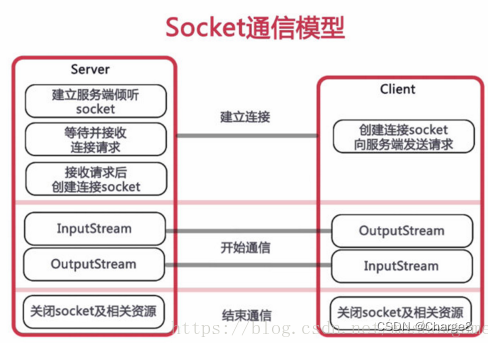
2、为什么需要WebSocket
HTTP 是基于请求响应式的,即通信只能由客户端发起,服务端做出响应,无状态,无连接。
- 无状态:每次连接只处理一个请求,请求结束后断开连接。
- 无连接:对于事务处理没有记忆能力,服务器不知道客户端是什么状态。
通过HTTP实现即时通讯,只能是页面轮询向服务器发出请求,服务器返回查询结果。轮询的效率低,非常浪费资源,因为必须不停连接,或者 HTTP 连接始终打开。
WebSocket的最大特点就是,服务器可以主动向客户端推送信息,客户端也可以主动向服务器发送信息,是真正的双向平等对话。
WebSocket特点:
- (1)建立在 TCP 协议之上,服务器端的实现比较容易。
- (2)与 HTTP 协议有着良好的兼容性。默认端口也是80和443,并且握手阶段采用 HTTP 协议,因此握手时不容易屏蔽,能通过各种 HTTP 代理服务器。
- (3)数据格式比较轻量,性能开销小,通信高效。
- (4)可以发送文本,也可以发送二进制数据。
- (5)没有同源限制,客户端可以与任意服务器通信。
- (6)协议标识符是ws(如果加密,则为wss),服务器网址就是 URL。
图来自参考文章:
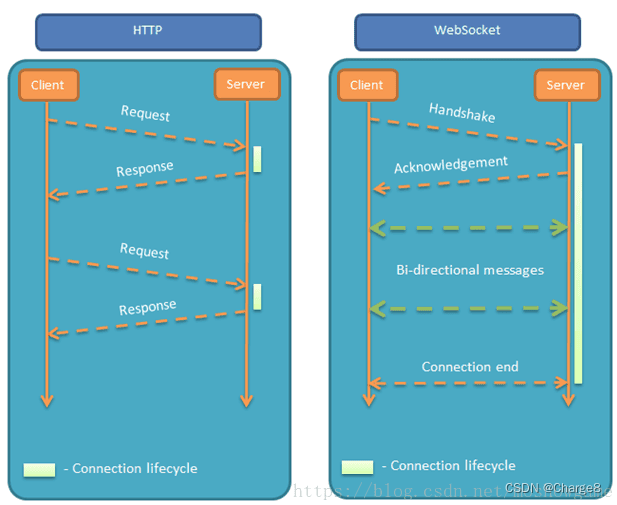
二、SpringBoot整合WebSocket
创建 SpringBoot项目,引入 WebSocket依赖,前端这里比较简陋。
<!-- websocket dependency --><dependency><groupId>org.springframework.boot</groupId><artifactId>spring-boot-starter-websocket</artifactId><version>2.7.12</version></dependency><dependency><groupId>org.springframework.boot</groupId><artifactId>spring-boot-starter-thymeleaf</artifactId><version>2.7.12</version></dependency>
application.yml:
server:port:8081spring:thymeleaf:mode: HTML
cache:trueprefix: classpath:/templates/
encoding: UTF-8suffix: .html
check-template-location:truetemplate-resolver-order:1
1、WebSocketConfig
启用 WebSocket的支持也是很简单。
/**
* WebSocket配置类。开启WebSocket的支持
*/@ConfigurationpublicclassWebSocketConfig{/**
* bean注册:会自动扫描带有@ServerEndpoint注解声明的Websocket Endpoint(端点),注册成为Websocket bean。
* 要注意,如果项目使用外置的servlet容器,而不是直接使用springboot内置容器的话,就不要注入ServerEndpointExporter,因为它将由容器自己提供和管理。
*/@BeanpublicServerEndpointExporterserverEndpointExporter(){returnnewServerEndpointExporter();}}
2、WebSocketServer
这里就是重点了,核心都在这里。
- 因为WebSocket是类似客户端服务端的形式(
采用ws协议),那么这里的WebSocketServer其实就相当于一个ws协议的Controller 直接@ServerEndpoint("/imserver/{userId}") 、@Component启用即可,然后在里面实现@OnOpen开启连接,@onClose关闭连接,@onMessage接收消息等方法。- 新建一个
ConcurrentHashMap用于接收当前userId的WebSocket或者Session信息,方便IM之间对userId进行推送消息。单机版实现到这里就可以。 - 集群版(多个ws节点)还需要借助 MySQL或者 Redis等进行订阅广播方式处理,改造对应的 sendMessage方法即可。
/**
* WebSocket的操作类
*/@Component@Slf4j/**
* html页面与之关联的接口
* var reqUrl = "http://localhost:8081/websocket/" + cid;
* socket = new WebSocket(reqUrl.replace("http", "ws"));
*/@ServerEndpoint("/websocket/{sid}")publicclassWebSocketServer{/**
* 静态变量,用来记录当前在线连接数,线程安全的类。
*/privatestaticAtomicInteger onlineSessionClientCount =newAtomicInteger(0);/**
* 存放所有在线的客户端
*/privatestaticMap<String,Session> onlineSessionClientMap =newConcurrentHashMap<>();/**
* 连接sid和连接会话
*/privateString sid;privateSession session;/**
* 连接建立成功调用的方法。由前端<code>new WebSocket</code>触发
*
* @param sid 每次页面建立连接时传入到服务端的id,比如用户id等。可以自定义。
* @param session 与某个客户端的连接会话,需要通过它来给客户端发送消息
*/@OnOpenpublicvoidonOpen(@PathParam("sid")String sid,Session session){/**
* session.getId():当前session会话会自动生成一个id,从0开始累加的。
*/
log.info("连接建立中 ==> session_id = {}, sid = {}", session.getId(), sid);//加入 Map中。将页面的sid和session绑定或者session.getId()与session//onlineSessionIdClientMap.put(session.getId(), session);
onlineSessionClientMap.put(sid, session);//在线数加1
onlineSessionClientCount.incrementAndGet();this.sid = sid;this.session = session;sendToOne(sid,"连接成功");
log.info("连接建立成功,当前在线数为:{} ==> 开始监听新连接:session_id = {}, sid = {},。", onlineSessionClientCount, session.getId(), sid);}/**
* 连接关闭调用的方法。由前端<code>socket.close()</code>触发
*
* @param sid
* @param session
*/@OnClosepublicvoidonClose(@PathParam("sid")String sid,Session session){//onlineSessionIdClientMap.remove(session.getId());// 从 Map中移除
onlineSessionClientMap.remove(sid);//在线数减1
onlineSessionClientCount.decrementAndGet();
log.info("连接关闭成功,当前在线数为:{} ==> 关闭该连接信息:session_id = {}, sid = {},。", onlineSessionClientCount, session.getId(), sid);}/**
* 收到客户端消息后调用的方法。由前端<code>socket.send</code>触发
* * 当服务端执行toSession.getAsyncRemote().sendText(xxx)后,前端的socket.onmessage得到监听。
*
* @param message
* @param session
*/@OnMessagepublicvoidonMessage(String message,Session session){/**
* html界面传递来得数据格式,可以自定义.
* {"sid":"user-1","message":"hello websocket"}
*/JSONObject jsonObject = JSON.parseObject(message);String toSid = jsonObject.getString("sid");String msg = jsonObject.getString("message");
log.info("服务端收到客户端消息 ==> fromSid = {}, toSid = {}, message = {}", sid, toSid, message);/**
* 模拟约定:如果未指定sid信息,则群发,否则就单独发送
*/if(toSid ==null|| toSid ==""||"".equalsIgnoreCase(toSid)){sendToAll(msg);}else{sendToOne(toSid, msg);}}/**
* 发生错误调用的方法
*
* @param session
* @param error
*/@OnErrorpublicvoidonError(Session session,Throwable error){
log.error("WebSocket发生错误,错误信息为:"+ error.getMessage());
error.printStackTrace();}/**
* 群发消息
*
* @param message 消息
*/privatevoidsendToAll(String message){// 遍历在线map集合
onlineSessionClientMap.forEach((onlineSid, toSession)->{// 排除掉自己if(!sid.equalsIgnoreCase(onlineSid)){
log.info("服务端给客户端群发消息 ==> sid = {}, toSid = {}, message = {}", sid, onlineSid, message);
toSession.getAsyncRemote().sendText(message);}});}/**
* 指定发送消息
*
* @param toSid
* @param message
*/privatevoidsendToOne(String toSid,String message){// 通过sid查询map中是否存在Session toSession = onlineSessionClientMap.get(toSid);if(toSession ==null){
log.error("服务端给客户端发送消息 ==> toSid = {} 不存在, message = {}", toSid, message);return;}// 异步发送
log.info("服务端给客户端发送消息 ==> toSid = {}, message = {}", toSid, message);
toSession.getAsyncRemote().sendText(message);/*
// 同步发送
try {
toSession.getBasicRemote().sendText(message);
} catch (IOException e) {
log.error("发送消息失败,WebSocket IO异常");
e.printStackTrace();
}*/}}
3、controller
controller中只有一个简单的界面跳转操作,其他的不需要。
@Controller@RequestMapping("/demo")publicclassDemoController{/**
* 跳转到websocketDemo.html页面,携带自定义的cid信息。
* http://localhost:8081/demo/toWebSocketDemo/user-1
*
* @param cid
* @param model
* @return
*/@GetMapping("/toWebSocketDemo/{cid}")publicStringtoWebSocketDemo(@PathVariableString cid,Model model){
model.addAttribute("cid", cid);return"websocketDemo";}}
4、websocketDemo.html
新建一个文件,放到 templates目录下面。页面简单使用js代码调用WebSocket。
<!DOCTYPEhtml><htmlxmlns:th="http://www.thymeleaf.org"><head><metacharset="UTF-8"><title>666666</title></head><body>
传递来的数据值cid:
<inputtype="text"th:value="${cid}"id="cid"/><p>【toUserId】:
<div><inputid="toUserId"name="toUserId"type="text"value="user-1"></div><p>【toUserId】:
<div><inputid="contentText"name="contentText"type="text"value="hello websocket"></div><p>【操作】:
<div><buttontype="button"onclick="sendMessage()">发送消息</button></div></body><scripttype="text/javascript">var socket;if(typeof(WebSocket)=="undefined"){
console.log("您的浏览器不支持WebSocket");}else{
console.log("您的浏览器支持WebSocket");//实现化WebSocket对象,指定要连接的服务器地址与端口 建立连接var cid = document.getElementById("cid").value;
console.log("cid-->"+ cid);var reqUrl ="http://localhost:8081/websocket/"+ cid;
socket =newWebSocket(reqUrl.replace("http","ws"));//打开事件
socket.onopen=function(){
console.log("Socket 已打开");//socket.send("这是来自客户端的消息" + location.href + new Date());};//获得消息事件
socket.onmessage=function(msg){
console.log("onmessage--"+ msg.data);//发现消息进入 开始处理前端触发逻辑};//关闭事件
socket.onclose=function(){
console.log("Socket已关闭");};//发生了错误事件
socket.onerror=function(){alert("Socket发生了错误");//此时可以尝试刷新页面}//离开页面时,关闭socket//jquery1.8中已经被废弃,3.0中已经移除// $(window).unload(function(){// socket.close();//});}functionsendMessage(){if(typeof(WebSocket)=="undefined"){
console.log("您的浏览器不支持WebSocket");}else{// console.log("您的浏览器支持WebSocket");var toUserId = document.getElementById('toUserId').value;var contentText = document.getElementById('contentText').value;var msg ='{"sid":"'+ toUserId +'","message":"'+ contentText +'"}';
console.log(msg);
socket.send(msg);}}</script></html>
5、测试运行效果
(1)访问页面,建立连接
启动项目,访问 http://localhost:8081/demo/toWebSocketDemo/{cid} 跳转到页面,然后就可以和WebSocket交互了。
这里开启三个浏览器的窗口:
http://localhost:8081/demo/toWebSocketDemo/user-1
http://localhost:8081/demo/toWebSocketDemo/user-2
http://localhost:8081/demo/toWebSocketDemo/user-3
然后打开浏览器的控制台。此时idea控制台中的输出信息如下所示。说明连接建立成功。
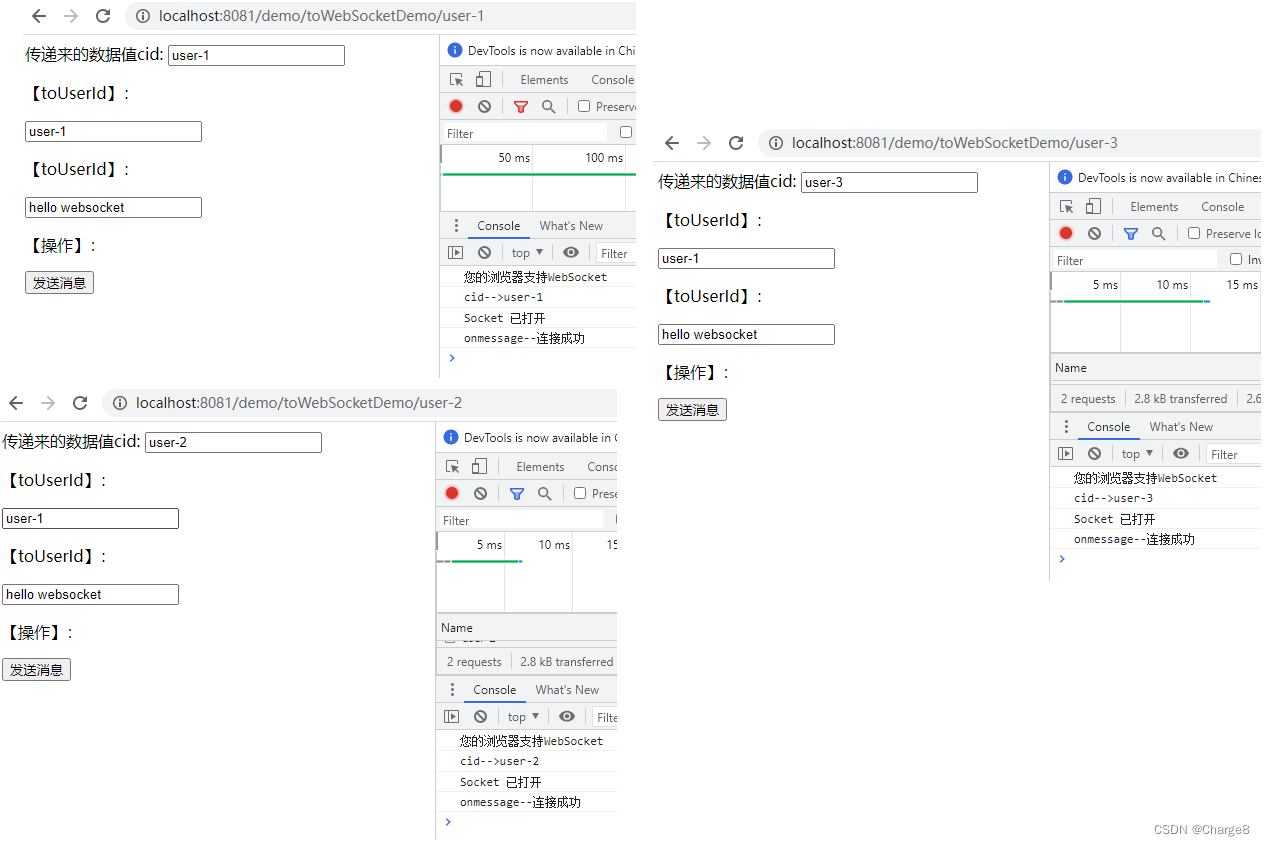
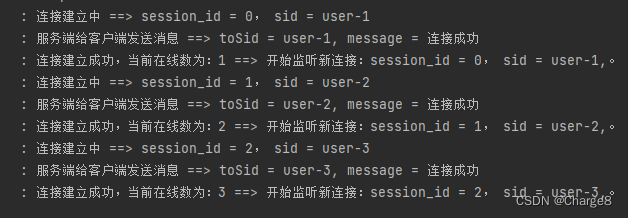
(2)指定sid发送消息
user-2给 user-1发送数据,也可以自己给自己发送数据。
指定的窗口能够收到数据,其他窗口收不到数据。

(3)群发送消息
user-3群发送数据。
在代码中定义群发的条件为:当不指定 toUserid时,则为群发。
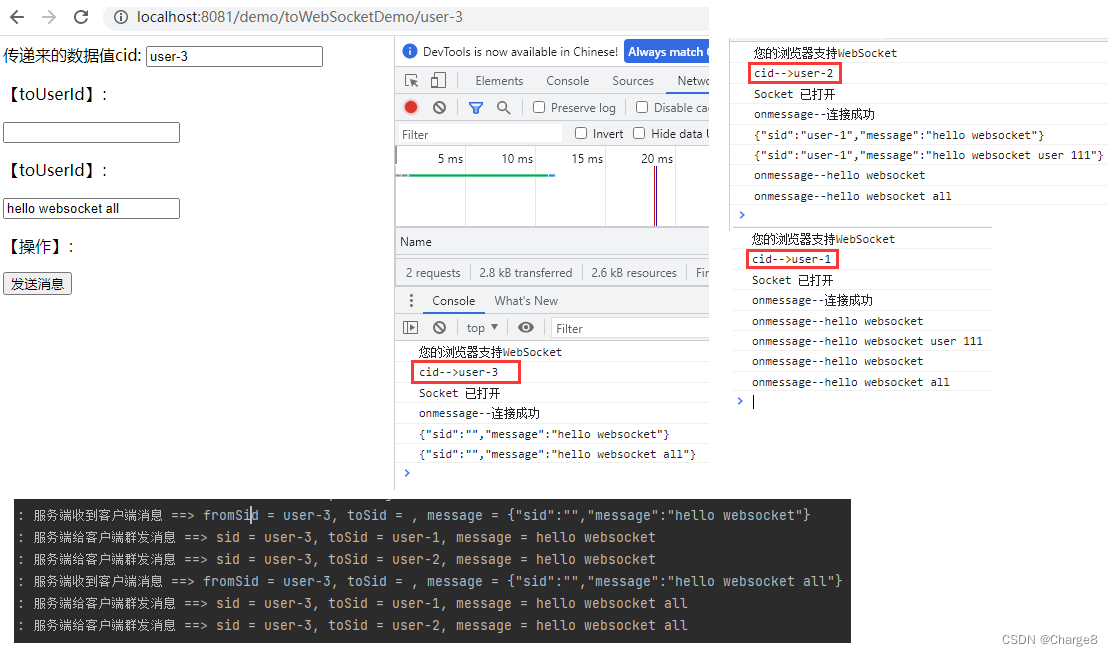
你学会了嘛。
参考文章:
- SpringBoot2.0集成WebSocket,实现后台向前端推送信息:https://blog.csdn.net/moshowgame/article/details/80275084
- SpringBoot整合WebSocket(session共享实现):https://blog.csdn.net/printf88/article/details/123685995
– 求知若饥,虚心若愚。
版权归原作者 Charge8 所有, 如有侵权,请联系我们删除。